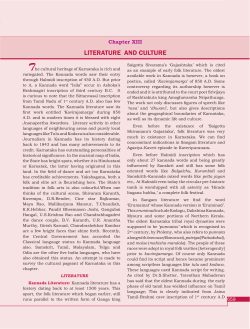
Celebrating the world of languages Language World Conference 2010 University of York
Celebrating the world of languages Language World Conference 2010 University of York Alyson Allan alysonallanlanguages@yahoo.co.uk Aims of the session • To share some ideas and activities to celebrate the wide range of languages spoken throughout the world • To share ideas for successful language days / weeks at your school How’s your Gujarati? Be a languages detective Identify the language rosso azzurro verde nero giallo hóngsè lánsè lù sè hēisè huángsè rood blauw groen zwart geel dearg gorm glas dubh buí röd blå gröng svart gul ? ? ? ? ? •Which language was the easiest to identify? Why? •Which was the most difficult? Why? •Any inspired guesswork? How did you arrive at this? •How could this activity teach children about language in general? Source : http://www.omniglot.com/language/colours/index.php#primary Identify the language • An example from a Nottinghamshire secondary school which used its link with a school in India to great effect. Mercredi le 3 février OBJECTIVES •To learn a basic dialogue in Kannada •To write a profile of our language learning LEARNING OUTCOMES •All of you will remember 1 or 2 words in Kannada, and much more French •Most of you will remember 4 or 5 words in Kannada, and most of the French; and share some strategies for learning foreign words •Some of you will remember a lot of Kannada words, and articulate some contrasting strategies for learning Kannada, as opposed to French Put the numbers in the correct order • Source : http://www.zompist.com/numbers.shtml Links with the KS2 Framework for Languages KAL • recognise that many languages are spoken in the UK and across the world • identify a different writing system • recognise patterns in simple sentences • recognise typical conventions of word order in different languages Links with the KS2 Framework for Languages LLS • discuss language learning and share ideas and experiences • use the context of what they see / read to determine some of the meaning • compare languages with English • use mental associations to help remember words • use context and previous knowledge to determine meaning and pronunciation • look and listen for visual and aural clues • make predictions based on existing knowledge • compare and reflect on techniques for memorising language Links with the KS2 Framework for Languages IU • • • • • • • Learn about different languages spoken by children at school Increase awareness of linguistic and cultural diversity Locate country / countries where language is spoken Identify social conventions Have contact with a native speaker View a video or media resource about the country Use photocopied pages from ELP to track and celebrate children’s language learning • Learn simple phrases to celebrate festivals • Look at writing system of different languages Links with the KS3 Framework for Languages IU • appreciate cultural diversity LLS • use knowledge of English or another language to work out meanings • identify patterns in target language Celebrating the European Day of Languages (EDL) • Celebrated every year on 26th September • Falls on a Sunday this year! • EDL aims : • To alert the public to the importance of language learning • To increase awareness and appreciation of all languages • To encourage lifelong language learning • To have fun! • Website details : http://www.cilt.org.uk/home/valuing_languages/european_d ay_of_languages.aspx What can you do? • Ideas from schools in Notts (handout) • Look at CILT website for more ideas and resources http://www.cilt.org.uk/edl/index.htm • Look at the Council of Europe site for even more ideas http://www.ecml.at/edl/default.asp?t=poster • Learn to say hello in other languages http://www.newburypark.redbridge.sch.uk/langofm onth/index.html What can you do? • • • • • • • • • • Treasure hunt using facts about European countries Language quiz Boules competitions Breakfast across Europe International menu Multilingual assembly International wall display Visiting speaker(s) Use Google images / Google earth See sheet of suggestions More ideas thanks to the internet • Activities sheet from EDL pages • Say hello to the world! http://www.ipl.org/div/hello/ • Words in English borrowed from other languages http://www.krysstal.com/borrow.html Celebrating languages diversity • The best ever website….. http://www.newburypark.redbridge.sch.uk/langofmont h • Language Investigator (Coventry LA) http://www.language-investigator.co.uk/ http://www.mandarintools.com/chinesename.html Identify the language rosso azzurro verde nero giallo hóngsè lánsè lù sè hēisè huángsè rood blauw groen zwart geel dearg gorm glas dubh buí röd blå gröng svart gul ? ? ? ? ? •Which language was the easiest to identify? Why? •Which was the most difficult? Why? •Any inspired guesswork? How did you arrive at this? •How could this activity teach children about language in general? Source : http://www.omniglot.com/language/colours/index.php#primary
© Copyright 2025














